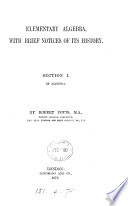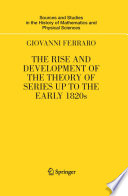 | John Mason Good - 1819 - 788 pages
...by the ultimate velocity i* meant that with which the body is moved, neither before it arrives at iu place and the motion ceases, nor after ; but at the...ratio of nascent quantities is that with which they benn to be. And the first or last sum is that with which they begin and cea«e to be (or to be augmented... | |
 | Thomas Curtis (of Grove house sch, Islington) - 438 pages
...ceases, nor after, but at the very instant it arrives ; that is, that velocity with which the body an ves at its last place, and with which the motion ceases....quantities is that with which they begin to be. And the tirst or last sum is that with which they begin and cease to be (or to be augmented and diminished).... | |
 | 1876 - 1088 pages
...evanescent quantities is to be understood the ratio of the quantities, not before they vanish, not afterwards, but with which they vanish. In like manner,...nascent quantities is that with which they begin to be." From this answer, which is so clear and so deep, it is manifest that infinitesimals are real quantities.... | |
 | 1876 - 1088 pages
...evanescent quantities is to be understood the ratio of the quantities, not before they vanish, not afterwards, but with which they vanish. In like manner,...nascent quantities is that with which they begin to be." From this answer, which is so clear and so deep, it is manifest that infinitesimals are real quantities.... | |
 | Robert Potts - 1879 - 668 pages
...the ratio of the quantities, not before they vanish, nor afterwards, but the ratio with which they do vanish. In like manner the first ratio of nascent...the first or last sum is that with which they begin and cease to be (or to be augmented or diminished). There is a limit which the velocity at the end... | |
 | Robert Potts - Algebra - 1879 - 672 pages
...the ratio of the quantities, not before they vanish, nor afterwards, but the ratio with which they do vanish. In like manner the first ratio of nascent...the first or last sum is that with which they begin and cease to be (or to be augmented or diminished). There is a limit •which the velocity at the end... | |
 | Douglas M. Jesseph - Mathematics - 1993 - 335 pages
...before the body comes to the place, is not its ultimate velocity; when it has arrived, there is none. But the answer is easy; for by the ultimate velocity...the first or last sum is that with which they begin and cease to be (or to be augmented or diminished). There is a limit which the velocity at the end... | |
 | John Lane Bell - Mathematics - 2005 - 354 pages
...which the body arrives at its last place, and with which the motion ceases. And in like manner, the by the ultimate ratio of evanescent quantities is...nascent quantities is that with which they begin to be. ... 1 Newton (1962), p. 29 The 16th and 17th Centuriesithe Founding of the Infinitesimal Calculus 85... | |
 | Giovanni Ferraro - Mathematics - 2007 - 392 pages
...velocity, before the body comes to the place, is not its ultimate velocity; when it has arrived, is none. But the answer is easy; for by the ultimate velocity...the first or last sum is that with which they begin and cease to be (or to be augmented or diminished). There is a limit which the velocity at the end... | |
| |